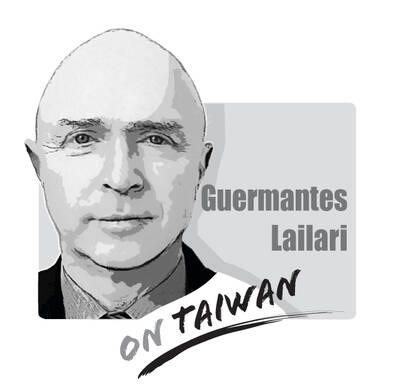A cropped image of Taichung Mayor Lu Shiow-yen (盧秀燕) pointing to a blackboard that says: “Year-end bonus... Every resident gets NT$40,000 [US$1,337]... Taichung has a NT$12 billion surplus... Academics urge the government to return the money to the people,” has been circulating online for several days.
After the Taichung City Government reported it to the police, an investigation was launched and the public was warned that under Article 63 of the Social Order Maintenance Act (社會秩序維護法), those who engage in “spreading rumors in a way that is sufficient to undermine public order and peace” could be detained for a maximum of three days or fined up to NT$30,000.
The term “rumor” refers to information that is fabricated or lacks factual basis.
Changhua District Court judgement No. 147 states that for a rumor to be “sufficient to undermine public order and peace,” it must cause “fear, panic or actual disturbance.” Therefore, merely spreading false content is not enough to meet that criteria.
The graphic’s use of the word “urge” implies that the measure has not been implemented. In other words, it is precisely because the city government has not yet used its surplus to distribute NT$40,000 cash handouts to residents that academics are calling on the government to do so. Where is the wrongdoing here? How is this considered “spreading rumors”?
Furthermore, the public did not experience feelings of “fear” or “panic” upon seeing the graphic — on the contrary, many expressed excitement or anticipation. Some even said: “Let all residents feel it — feel Lu’s love for the people of Taichung” and “NT$40,000 could relieve residents’ hardships.”
The graphic does not contravene the law, yet Lu reported it to the police, leading to citizens being investigated. Could this be an attempt by Lu to instill fear and restrict Taichung residents’ freedom of speech?
Yeh Yu-cheng is a secretary at the Pingtung County Public Health Bureau.
Translated by Kyra Gustavsen

Chinese state-owned companies COSCO Shipping Corporation and China Merchants have a 30 percent stake in Kaohsiung Port’s Kao Ming Container Terminal (Terminal No. 6) and COSCO leases Berths 65 and 66. It is extremely dangerous to allow Chinese companies or state-owned companies to operate critical infrastructure. Deterrence theorists are familiar with the concepts of deterrence “by punishment” and “by denial.” Deterrence by punishment threatens an aggressor with prohibitive costs (like retaliation or sanctions) that outweigh the benefits of their action, while deterrence by denial aims to make an attack so difficult that it becomes pointless. Elbridge Colby, currently serving as the Under
The Ministry of the Interior on Thursday last week said it ordered Internet service providers to block access to Chinese social media platform Xiaohongshu (小紅書, also known as RedNote in English) for a year, citing security risks and more than 1,700 alleged fraud cases on the platform since last year. The order took effect immediately, abruptly affecting more than 3 million users in Taiwan, and sparked discussions among politicians, online influencers and the public. The platform is often described as China’s version of Instagram or Pinterest, combining visual social media with e-commerce, and its users are predominantly young urban women,
Most Hong Kongers ignored the elections for its Legislative Council (LegCo) in 2021 and did so once again on Sunday. Unlike in 2021, moderate democrats who pledged their allegiance to Beijing were absent from the ballots this year. The electoral system overhaul is apparent revenge by Beijing for the democracy movement. On Sunday, the Hong Kong “patriots-only” election of the LegCo had a record-low turnout in the five geographical constituencies, with only 1.3 million people casting their ballots on the only seats that most Hong Kongers are eligible to vote for. Blank and invalid votes were up 50 percent from the previous
Alarm bells over a “hollowing out” of Taiwan’s semiconductor industry and US demands for “protection money” have fueled a panic over Taiwan. To understand how misplaced these fears are, consider the movements of global technology giants. Nvidia Corp CEO Jensen Huang (黃仁勳), Advanced Micro Devices Inc (AMD) CEO Lisa Su (蘇姿丰) and Taiwan Semiconductor Manufacturing Co (TSMC) chairman C.C. Wei (魏哲家) could undoubtedly understand the situation best, and they continue to make key investments in Taiwan. They do not make decisions on a whim. They are the architects of global computing power strategy and possess the highest levels of industry knowledge. No